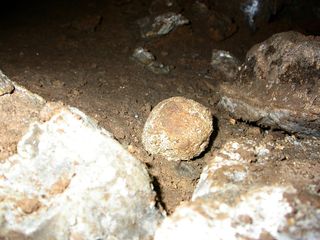Fossilized Poop Reveals Ancient Hyena's Main Entrée

By reading the genes in ancient poop, researchers have uncovered the diet and descendents of the cave hyena, which roamed throughout Eurasia alongside the Neanderthals.
The cave hyena, named Crocuta crocuta spelaea, lived for about 1 million years in Eurasia, before dying out some 10,000 to 30,000 years ago. Not only were they about 25 percent larger than modern hyenas, they were also more powerful and had a stronger bite, study researcher Jean-Marc Elalouf, of the Instituteof Biology and Technology Saclay, in France, told LiveScience.
The new data suggest that these prehistoric predators were probably a subspecies of the modern spotted hyena and liked to dine on red deer.
Cave poop
Elalouf and colleagues extracted DNA from nine specimens of fossilized dung, called coprolites, from a cave in the French Pyrenees. Two samples yielded good results, which the researchers analyzed further.
They specifically looked at DNA in the dung's mitochondria, or the cells' energy-generating structures. By comparing this genetic data with the mitochondrial genes of living hyenas, the researchers found that this cave hyena is very closely related to the modern spotted hyena, and less closely related to the modern striped hyena.
The results support previous studies that have indicated the "cave hyena" was an ancient subspecies of the modern spotted hyena — and should therefore be called the "Ice Age spotted hyena," Cajus Diedrich, a researcher from the Paleo-Logic Research Institute in Germany who wasn't involved in the study, told LiveScience in an email.
Sign up for the Live Science daily newsletter now
Get the world’s most fascinating discoveries delivered straight to your inbox.
Hyena dinner
The DNA also suggested the hyena feasted mainly on red deer, something researchers had suspected based on bite marks found on deer bones in caves. The genetic data is confirmation of the diet, since it is less biased than bone finds; some animal bones are less likely to survive to modern times, Elalouf said.
In addition, "the DNA information could give us valuable insights into the population structure of the European populations in the run-up to their extinction," study researcher Gerrit Dusseldorp, of the University of Witwatersrand, in South Africa, told LiveScience.
The study will be published tomorrow, March 28, in the journal Proceedings of the Royal Society B: Biological Sciences.
You can follow LiveScience staff writer Jennifer Welsh on Twitter @microbelover. Follow LiveScience for the latest in science news and discoveries on Twitter @livescience and on Facebook.
Jennifer Welsh is a Connecticut-based science writer and editor and a regular contributor to Live Science. She also has several years of bench work in cancer research and anti-viral drug discovery under her belt. She has previously written for Science News, VerywellHealth, The Scientist, Discover Magazine, WIRED Science, and Business Insider.
Most Popular



